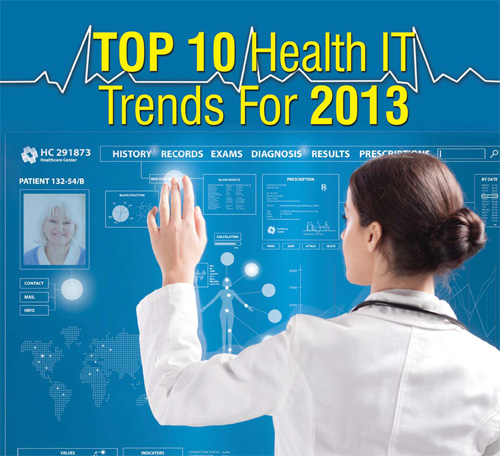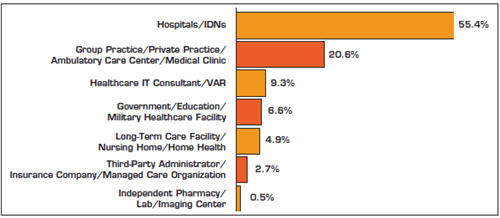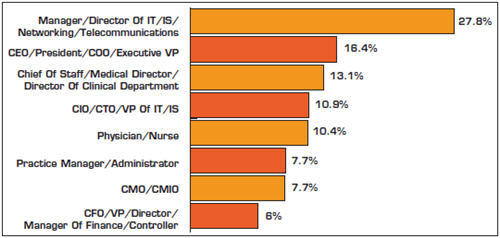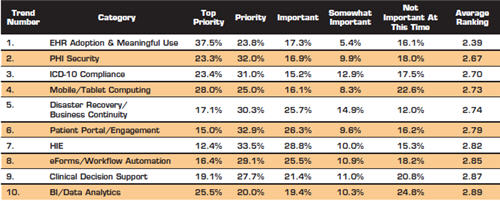Top 10 Health IT Trends For 2013
By Ken Congdon, Editor In Chief, Health IT Outcomes
Not surprisingly, EHR Adoption & Meaningful Use tops our list of health IT trends again this year, but as the healthcare landscape becomes more electronic, some interesting new IT initiatives are beginning to emerge.

It’s not easy being a healthcare technology leader these days. Healthcare reform, HITECH incentives, ICD-10 mandates, and a series of other factors are forever changing the healthcare landscape. As a result, hospitals, physicians practices, and other health providers are implementing technology as a primary means to roll with these changes and thrive in healthcare’s brave new world. While definitely an exciting time, it’s also a bit chaotic. There are so many health IT demands being placed on healthcare providers today that educated prioritization of technology initiatives is of the utmost importance. To gain insight into which technology initiatives will carry the most weight with providers in the coming year, Health IT Outcomes (HTO) surveyed nearly 200 (183) healthcare providers from its readership.
RESEARCH SAMPLE
HTO’s 183 survey respondents were selected at random and were a fair representation of our total circulation of 66,000 IT decision makers from the provider community. The majority of respondents (55.4%) represented hospitals and integrated delivery networks (IDNs), followed by group and private practices/medical clinics/ambulatory care centers (20.6%). Some health IT consultants, systems integrators, and value-added resellers (9.3%) were also included in the survey given their involvement in and influence over the IT implementations of many healthcare providers. A complete facility breakdown of our survey respondents is presented in Figure 1.
Figure 1: Facility Breakdown

IT, clinical, and executive titles were well represented in our sample, with IT leadership (includes CIOs and CTOs) accounting for 38.7% of respondents, C-level executives (e.g. CEO, COO, CFO, CMO, CMIO, etc.) accounting for 30.1%, and clinical leaders accounting for 23.5%. Details regarding the complete title breakdown of our survey respondents can be found in Figure 2.
Figure 2: Title Breakdown

Of the hospitals and IDN contacts that responded to the survey, 29% were from hospitals with 500 beds or more, 20.4% were from hospitals with 300-499 beds, 33.3% represented hospitals with 100 to 299 beds, and 17.3% were from hospitals with fewer than 100 beds. Of the private/ group practices, medical clinics, and ambulatory care centers that responded to the survey, 39.3% represented facilities with more than 25 physicians, 21.4% represented facilities with 10 to 25 physicians, 28.6% represented facilities with 3 to 9 physicians, and 10.7% represented facilities with 1 or 2 physicians.
SURVEY METHODOLOGY
To identify the top technology trends, HTO asked each of the survey respondents to rank a series of health IT initiatives in line with their implementation plans for 2013. For each initiative, respondents were asked to clarify whether the initiative was a “Top Priority,” a “Priority,” “Important,” “Somewhat Important,” or “Not Important At This Time.” Each response was then weighted. For example, all “Top Priority” responses were given a rating of one, while “Not Important At This Time” responses were given a rating of five. An average of the total ratings was then calculated for each IT initiative. The lower the cumulative rating, the higher the priority the technology initiative was to our survey respondents. This rating system was used to determine the top 10 health IT trends for 2013. These top-performing trends are outlined in Figure 3.
Figure 3: The Top 10 Health IT Trends For 2013

KEY FINDINGS
Our survey indicates that several key health IT initiatives from 2012 will carry over into 2013. In fact, 6 of the top 10 health IT trends for 2013 (EHR Adoption & Meaningful Use, PHI Security, ICD-10 Compliance, Mobile/Tablet Computing, HIE, and Clinical Decision Support) were on our list last year. This isn’t surprising, since many of the IT projects healthcare providers are currently engaged in don’t have plug and play solutions. For these initiatives, achieving desired outcomes is more of a journey than it is a destination.
This “journey” to health IT adoption is exemplified by EHR Adoption & Meaningful Use, which was voted by our readers as the number one IT trend for the second year in a row. Providers don’t simply purchase EHR software, install it, and start using it effectively out of the box. The implementation and training process is more often a grueling ordeal that requires phased rollouts and ongoing technology and workflow adjustments.
While our list of 2013 health trends is similar to our 2012 installment, there are some compelling new trends to crack our top 10 this year. For example, Disaster Recovery/Business Continuity moved from the number 11 spot in 2012 to number 5 on this year’s list. I believe the continuity issues many hospitals faced in the wake of Hurricane Sandy were influential in moving disaster recovery initiatives up on provider IT priority lists.
Patient Portals/Patient Engagement also broke into our top 10 this year at the number 6 position (number 12 in 2012). The emphasis CMS placed on patient engagement in its release of its Stage 2 Meaningful Use requirements has undoubtedly prompted healthcare facilities to solidify plans to implement patient-facing systems and services.
Finally, Business Intelligence/Data Analytics moved from the 15th most popular health IT trend in 2012 to 10th position this year. As healthcare providers implement EHRs, there is an increased need to aggregate, manipulate, and display the electronic data contained within these systems to simplify performance measurement and improvement. Business intelligence and data analytics tools are increasingly being leveraged for this purpose.
BIGGEST SURPRISES
While much of our Top 10 list trended as expected, there were a few surprising revelations from our survey. For example, even with the Supreme Court upholding the Affordable Care Act, President Obama’s re-election, and more than 100 new Accountable Care Organizations (ACOs) joining the Medicare shared savings program in the new year, ACO Preparedness continues to be an afterthought for most of our survey respondents. In fact, 27.2% of our respondents stated that ACO Preparedness was “Not Important At This Time.” However, there is some indication that the ACO concept may be gaining traction with some providers as this initiative ranked slightly higher on our 2013 list (#25) than in 2012 (#33).
Another head-scratcher was how poorly BYOD (bring your own device) Management performed on our survey. Nearly 33% of respondents stated that this initiative was “Not Important At This Time.” This was not only confusing considering the activity and interest BYOD focused articles received on HTOinfo.com in 2012, but also because of how well Mobile/Tablet Computing performed on the same survey. Mobile/Tablet Computing finished as the #4 trend for 2013, with 53% of our audience ranking this technology initiative as either a “Top Priority” or “Priority.” Are the majority of healthcare facilities continuing to follow a strict corporate-issued device model, or are they allowing BYOD and ignoring the policies and technologies necessary to shore up these initiatives? In any case, there seems to be a potentially frightening contradiction here.
Lastly, I was a bit surprised that Telehealth/Telemedicine dropped out of the top 10 this year. I expected this trend to perform better given the impact these solutions can have on chronic disease management and the improved financial incentives surrounding telehealth. Perhaps lingering reimbursement questions are keeping telehealth solutions on the back burner.
NEXT STEPS
Obviously, I have only scratched the surface in examining the health IT trends uncovered as part of our survey. On the following pages, several health IT visionaries provide their insights and commentary on our top 10 trends. Also, you can view a full list of the health IT initiatives that were included as part of our survey and how each ranked with our respondents (even if they didn’t make the top 10) by scanning the mobile tag to the left or visiting www.htoinfo.com/go/results2013.
